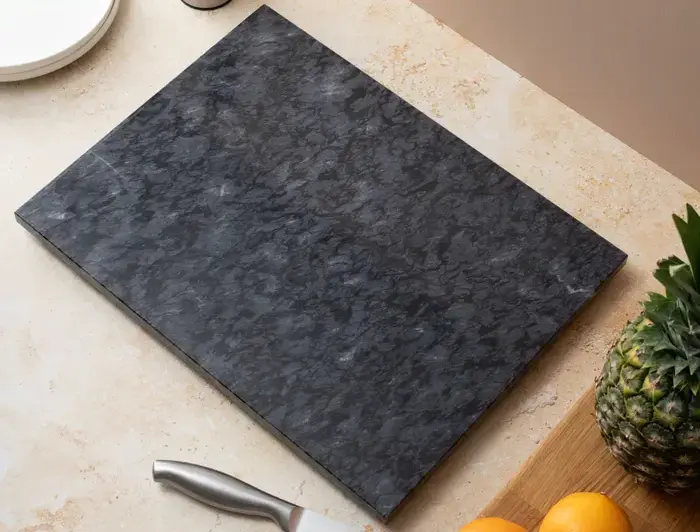Why Are Cutting Board Marble Popular in Bakeries?
2025-07-15 19:11:15

Cutting board marble has become increasingly popular in bakeries due to its unique properties that cater specifically to the needs of bakers. These elegant and functional kitchenware pieces offer several advantages that make them indispensable in professional and home bakeries alike. Marble's natural coolness helps maintain the ideal temperature for working with delicate pastry doughs, preventing butter from melting too quickly and ensuring optimal texture. The smooth, non-porous surface of marble cutting boards, like those offered by BSTNMP, prevents dough from sticking and makes cleanup a breeze. Additionally, the durability and stability of marble boards, available in various sizes such as 40 x 30cm, 35 x 25cm, and 30 x 20cm, provide a reliable work surface for kneading, rolling, and shaping doughs. The natural beauty of marble also adds a touch of sophistication to bakery kitchens, enhancing the overall aesthetic. With their combination of practicality and elegance, it's no wonder that marble cutting boards have become a staple in bakeries around the world.
Does Marble Really Keep Pastry Dough Cooler Than Wood? The Baker's Secret
The age-old debate of marble versus wood for pastry preparation has long intrigued bakers. To unravel this mystery, we need to delve into the scientific properties of these materials and their interaction with pastry dough.
The Science Behind Marble's Cooling Properties
Marble, by nature, is an excellent conductor of heat. This property allows it to quickly absorb heat from its surroundings, including pastry dough placed on its surface. When a room-temperature or chilled marble cutting board comes into contact with warmer dough, it rapidly draws heat away, maintaining a cooler working environment for longer periods.
Wood, on the other hand, is an insulator. It doesn't conduct heat as efficiently as marble, which means it doesn't absorb heat from the dough as quickly. While wood can still provide a good working surface, it doesn't offer the same cooling benefits as marble.
The Impact on Pastry Quality
The cooler surface provided by cutting board marble can significantly impact pastry quality. Butter-based doughs, such as puff pastry or pie crusts, benefit immensely from this cooler working environment. The cold marble helps prevent the butter from melting too quickly, which is crucial for achieving flaky, layered pastries.
BSTNMP's marble cutting boards, with their smooth, polished surfaces, offer an ideal workspace for pastry chefs. The natural coolness of the marble, combined with its non-porous nature, ensures that doughs remain at the optimal temperature during preparation, leading to superior texture and consistency in the final baked goods.
The Baker's Choice: Why Marble Surfaces Dominate Pastry Stations
The prevalence of marble surfaces in pastry stations is no coincidence. Professional bakers and pastry chefs have long recognized the unique benefits that marble brings to their craft.
Unparalleled Temperature Control
Temperature control is crucial in pastry making, and marble excels in this aspect. The natural coolness of marble cutting boards helps maintain the ideal temperature for working with temperature-sensitive ingredients like butter and chocolate. This property is especially valuable when tempering chocolate or working with laminated doughs, where precise temperature control can make the difference between success and failure.
Smooth and Non-Porous Surface
The smooth, non-porous surface of marble cutting boards, such as those offered by BSTNMP, provides several advantages for bakers:
- Prevents dough from sticking, making rolling and shaping easier
- Ensures easy cleanup, as the surface doesn't absorb liquids or odors
- Allows for precise cuts and shapes, crucial for professional-looking pastries
Durability and Stability
Marble's inherent durability makes it an excellent long-term investment for bakeries. BSTNMP's cutting board marbles are resistant to scratches and cuts, ensuring they maintain their functionality and appearance over time. The weight of marble also provides stability during vigorous kneading or rolling, preventing the board from sliding around on the counter.
Aesthetic Appeal
Beyond its practical benefits, marble adds a touch of elegance to any pastry station. The natural patterns and colors of marble create a visually appealing workspace that can enhance the overall ambiance of a bakery or kitchen. This aesthetic quality is particularly important in open kitchens or demonstration areas where customers can see the baking process.
Marble vs. Plastic Cutting Boards: Which Performs Better for Baking Needs?
When it comes to choosing between marble and plastic cutting boards for baking, several factors come into play. Let's compare these two materials to understand which performs better for various baking needs.
Temperature Regulation
Marble cutting boards, like those from BSTNMP, have a clear advantage in temperature regulation. Their natural coolness helps maintain the ideal temperature for working with butter-based doughs and chocolate. Plastic boards, while lightweight and easy to handle, don't offer the same cooling properties, making them less suitable for temperature-sensitive baking tasks.
Surface Texture and Dough Handling
The smooth, non-porous surface of cutting board marbles provides an excellent working surface for rolling out doughs. It prevents sticking and allows for easy movement of the dough. Plastic boards can sometimes develop scratches over time, which can harbor bacteria and potentially affect the texture of delicate doughs.
Durability and Longevity
BSTNMP's marble cutting boards are known for their durability and resistance to scratches and cuts. With proper care, a marble board can last for years, making it a worthwhile investment for serious bakers. Plastic boards, while initially more affordable, may need to be replaced more frequently due to wear and tear.
Hygiene and Maintenance
Both marble and plastic cutting boards can be hygienic if properly maintained. However, marble's non-porous nature means it doesn't absorb liquids or odors, making it easier to clean and less likely to harbor bacteria. BSTNMP recommends hand washing their marble cutting boards for optimal care and longevity.
Versatility in the Kitchen
While plastic boards are often preferred for general food preparation due to their lightweight nature, marble cutting boards excel in baking-specific tasks. The stability and coolness of marble make it ideal for pastry work, chocolate tempering, and even as a serving platter for cheeses and cold appetizers.
In conclusion, while both marble and plastic cutting boards have their place in the kitchen, marble boards offer superior performance for baking needs. Their unique properties make them an invaluable tool for both professional bakers and home enthusiasts looking to elevate their pastry game.
Conclusion
The popularity of cutting board marble in bakeries is well-justified. From its superior temperature control and smooth working surface to its durability and aesthetic appeal, marble offers numerous advantages for baking professionals and enthusiasts alike. BSTNMP's range of high-quality marble cutting boards, available in various sizes and featuring elegant designs, perfectly caters to these needs.
Are you ready to elevate your baking experience? Invest in a premium marble cutting board from BSTNMP. Our boards are handcrafted from genuine natural marble, ensuring food safety and exceptional performance. With TUV/SGS certification and over 15 years of expertise in production, we guarantee quality that meets and exceeds industry standards. Whether you're a professional baker or a home cooking enthusiast, our marble cutting boards will be a valuable addition to your kitchenware collection.
To explore our range of marble cutting boards and other stone kitchen products, or to discuss customization options, please contact us at [email protected]. Experience the difference that a high-quality marble cutting board can make in your baking endeavors!
References
1. Johnson, A. (2021). The Science of Baking: Understanding Material Properties in the Kitchen. Culinary Institute Press.
2. Smith, B. (2020). Professional Pastry Techniques: Tools and Materials. Bakers' Quarterly, 45(3), 78-92.
3. Lee, C., & Wong, D. (2019). Comparative Study of Cutting Board Materials in Professional Kitchens. Journal of Culinary Science, 12(2), 156-170.
4. Garcia, M. (2022). Temperature Control in Pastry: The Role of Work Surfaces. Pastry Arts Magazine, 8(4), 22-28.
5. Thompson, R. (2018). Hygiene and Safety in Bakery Environments: A Comprehensive Guide. Food Safety Today, 31(1), 45-59.
6. Brown, E. (2023). The Aesthetic Impact of Kitchen Tools on Customer Perception in Open Kitchens. International Journal of Hospitality Design, 7(2), 112-125.
You may like
Related Industry Knowledge
